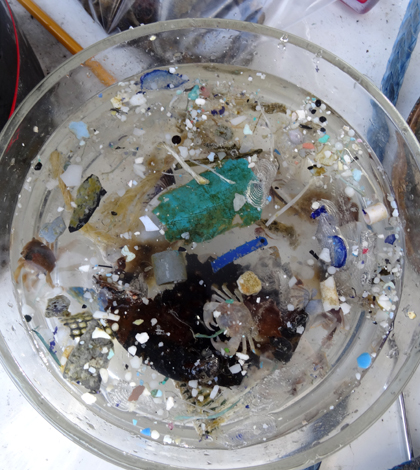In the North Pacific Gyre, sampling the Great Pacific Garbage Patch’s plastics

The first sample collected before arriving at the center of the North Pacific Gyre. (Credit: Lorena Mendoza)
There are five systems of large, rotating ocean currents in the world’s oceans. Oceanographers know them as gyres, and many are familiar with just one of them: the North Pacific Gyre. Full of tiny bits of plastic debris, this area has come to be known as the Great Pacific garbage patch.
Though that term implies that large plastic items are floating in a gargantuan mat of trash as far as the eye can see, the reality is that much of the plastic in the North Pacific is small or broken down into tiny particles. But the area still has much higher concentrations of plastics than others and scientists have long been interested in how those levels affect zooplankton, fish and the millions of animals living in the North Pacific.
Lorena Mendoza, an assistant professor of chemistry at the University of Wisconsin – Superior, will be in the region aboard the R/V Alguita for much of July. She is studying the potential of plastic particles to absorb substances like pesticides, PCBs and other persistent organic pollutants. When plastics suck up the substances, pollutants can concentrate at the surface of the ocean instead of sinking to the bottom and working their way into sediment. This makes them more available to fish and other animals looking for food, and contributes to their passage to other creatures in the food chain.
Mendoza first saw the North Pacific Gyre seven years ago. “In my experience from 2007, I can notice that we’re finding more and more plastic debris outside the gyre,” she said. “The gyre is the center of the concentration of plastic debris with lots of plastic fragments in different sizes and colors.”
Her work will involve using manta trawls — underwater nets with broad metal wings and gaping mouths said to resemble manta rays — to take samples of the floating plastic debris at different depths. From there, she will pass seawater through glass filters allowing her to collect microscopic plastic fragments.

The R/V Alguita, a 50-foot catamaran. (Credit: Lorena Mendoza)
In previous investigations, Mendoza found that plastic can absorb pollutants in much the same amounts as sediment. Plastics, she says, are a reliable avenue through which toxic compounds can concentrate near the surface of the ocean. And with the garbage patch there spanning a size twice as large as Texas, the North Pacific has a lot of plastic.
The Algalita Marine Research Institute, which is sponsoring the expedition, will analyze the quantities of plastic and zooplankton collected. In 1999, the research institute found a six-to-one ratio of plastics to zooplankton.
“This means six kilos of plastics against one kilo of natural food (for fish and other marine animals),” said Mendoza. “In 2007, we found 44 to one.” And she expects the ratio will again increase once findings from this year’s study are available.
Without conclusions from the current expedition, she still has recommendations for mitigating the Great Pacific garbage patch.
“My advice is follow the three R’s: Reuse, reduce and recycle,” said Mendoza. “And add one more R: Refuse to use plastics.”
Top image: The first sample collected before arriving at the center of the North Pacific Gyre. (Credit: Lorena Mendoza)




Christian Wagley
July 17, 2014 at 8:10 am
Some things to consider here: While marine debris is very visible and ugly and thus tugs at people’s emotions, it’s not even close to being the biggest issue facing our oceans and waterways. That would be nutrient pollution, overfishing, climate change (ocean acidification), coastal pollution, habitat loss, and on and on. The other thing is that the solutions proposed–that Americans should use less plastic–is also rather irrational. We should use less plastic in the U.S., but doing so will not significantly impact the amount of plastic floating around the Pacific. It appears that plastic at sea comes from Asian coastal cities where there is no garbage collection, and other cities where litter runs down storm drains and into the sea. If we want to stop plastic pollution in the ocean we need to fund garbage collection in poor Asian cities, and the retrofitting of stormwater systems so that they collect and purify runoff–including litter.
Mike Danielson
September 14, 2015 at 12:21 pm
A question I have is what has the development of the garbage patch done to effect the rotation of the Pacific Gyre? Has it slowed it down? is the water temperature due to the mass of the garbage increasing? could these be some of the contributing factors that have help create out un-presented stream of tropical storms in the eastern pacific? This is not just El Nino. The rapid shift to El Nino this year has gone understated in the ENSO reports. The tracks by, and between Hawaii and the mainland is unprecedented.
Thoughts?
Mike Danielson
PV Sailing~~_/)~~ The Ocean in Purgatory Project